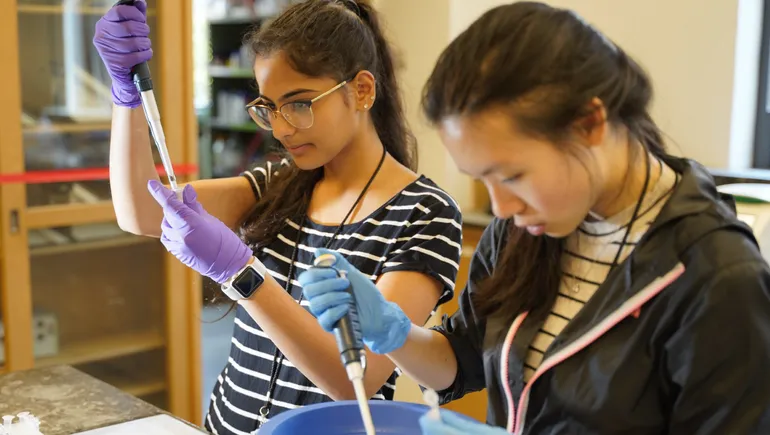Many students are still unable to acquire a STEM degree because the pipeline from high school to a degree in STEM remains inequitable and inaccessible.
A National Science Board report found that high school science and math performance is not equally distributed across the country, with vast differences in performance based on race, ethnicity and socioeconomic background. Research also shows that completing STEM coursework at the high school level significantly facilitates STEM-related postsecondary education and employment. Due to the unequal distribution of quality high-school STEM education in the U.S., STEM college degree enrollments vary greatly, with Black students and students from low-income families, for example, enrolling at much lower rates than their peers.
To ensure the long-term academic success of all students passionate about STEM, interventions at the high school level are increasingly crucial.
Immersive STEM experiences allow teens to ‘do’ science through collaboration
Immersive learning encourages active problem-solving, decision making and the application of knowledge. STEM education exposes teenagers to realistic lab and research scenarios and challenges them to think critically and collaboratively, leading to a deeper level of comprehension and skills transferable to professional and rigorous academic settings.
Organizations like SSP International are pioneering immersive STEM education for teens, offering transformational experiences on college campuses across the U.S. to high school juniors and seniors. The nonprofit’s signature program, The Summer Science Program, is the longest-running research-based science education program for high schoolers, offering rigorous scientific experimentation in astrophysics, biochemistry, genomics and synthetic chemistry.
Students need the cultural and social tools necessary to succeed in STEM
Too often, students from underrepresented backgrounds, including first-generation students or students of color, experience psychological and social challenges that negatively impact academic persistence, completion and performance. A recent study found that Black students in less racially diverse programs are more likely to feel discriminated against and physically and psychologically unsafe, leading them to abandon their higher education goals.
It’s crucial that students not only receive in-depth STEM education but are also equipped with the cultural capital needed to successfully navigate academia, the lab and collegiate environments. Young people can benefit greatly from programs like SSP International, which equips students who lack exposure to traditional academic environments with the tools to build strong mentor relationships, develop a collaborative approach to communication and research, advocate for themselves and participate in activities that lead to academic and social success.
Partnerships with colleges nationwide increase access to science
When high school students have access to university campuses, resources and faculty, they are exposed to a higher level of learning and a world of academic and career options typically unavailable to teens before college. With various campuses across the country, SSP International makes science research available to more young people and taps into the unique expertise of STEM departments at different institutions. Strong university partnerships allow for greater connections and learning opportunities for students.
This summer, the Summer Science Program is doubling the number of student placements to nearly 400 participants with new partnerships with Georgia College & State University, Georgetown University and Southwestern Oklahoma State University, in addition to long-standing partnerships with Indiana University Bloomington, New Mexico State University, Purdue University, the University of Colorado Boulder and the University of North Carolina at Chapel Hill.
These new partnerships will reach even more deserving participants, particularly first-generation students, as well as Black, Latino and low-income students, increasing access to high-quality science education for those historically underrepresented in STEM.
Offering stipends leads to college and career success in the future
To further close the representation gap in STEM, organizations can offer stipends to participants who would otherwise have to work in the summer. When students are financially supported based on need and financial barriers are removed, especially for Black and Latino students who are more likely to pay for college themselves, enrollment increases and students complete their degrees faster.
Beginning this summer SSP International will offer $3,000 stipends to qualified participants who would benefit from added financial support.
By partnering with SSP International, colleges can attract a cohort of talented and diverse students and close the STEM representation gap
To continue supporting underrepresented students in STEM fields, universities can turn to organizations already mentoring such high school students who are also passionate about science. If you’d like to bring students and promote diversity in STEM, consider bringing the Summer Science Program to your campus. Learn more about this opportunity here.
#STEM #pipeline #begins #high #school










